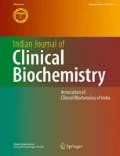Abstract
Type 2 diabetes mellitus consists of dysfunctions characterized by hyperglycemia and resulting from combination of resistance to insulin action and inadequate insulin secretion. Most of diabetic patients report significant gastrointestinal symptoms. Entire GI tract can be affected by diabetes from oral cavity to large bowel and anorectal region. Proteins, carbohydrates, fats, and most fluids are absorbed in small intestine. Malabsorption may occurs when proper absorption of nutrients does not take place due to bacterial overgrowth or altered gut motility. The present study was planned to measure various malabsorption parameters in type 2 diabetic patients. 175 patients and 175 age and sex matched healthy controls attending Endocrinology Clinic in PGI, Chandigarh were enrolled. Lactose intolerance was measured by using non-invasive lactose hydrogen breath test. Urinary d-xylose and fecal fat were estimated using standard methods. Orocecal transit time and small intestinal bacterial overgrowth were measured using non-invasive lactulose and glucose breath test respectively. Out of 175 diabetic patients enrolled, 87 were males while among 175 healthy subjects 88 were males. SIBO was observed in 14.8 % type 2 diabetic patients and in 2.8 % of controls. There was statistically significant increase (p < 0.002) in OCTT in type 2 diabetic patients compared with controls. OCTT was observed to be more delayed (p < 0.003) in patients who were found to have SIBO than in patients without SIBO. Lactose intolerance was observed in 60 % diabetic patients and 39.4 % in controls. Urinary d-xylose levels were also lower in case of diabetic patients but no significant difference was found in 72 h fecal fat excretion among diabetic patients and controls. Urinary d-xylose and lactose intolerance in SIBO positive type 2 diabetic patients was more severe as compared to SIBO negative diabetic patients. From this study we can conclude that delayed OCTT may have led to SIBO which may have instigated the process of malabsorption among type 2 diabetic patients.



Similar content being viewed by others
References
Joshi SR, Parikh RM. India—diabetes capital of the world: now heading towards hypertension. J Assoc Physicians India. 2007;55:323–4.
Kumar A, Goel MK, Jain RB, Khanna P, Chaudhary V. India towards diabetes control: key issues. Australas Med J. 2013;6(10):524–31.
Whiting DR, Guariguata L, Weil C, Shaw J. IDF, diabetes atlas. Global estimates of the prevalence of diabetes for 2011 and 2030. Diabetes Res Clin Pract. 2011;94:311–21.
Anjana RM, Ali MK, Pradeepa R, Deepa M, Datta M, Unnikrishnan R, et al. The need for obtaining accurate nationwide estimates of diabetes prevalence in India—rationale for a national study on diabetes. Indian J Med Res. 2011;133:369–80.
Bjornsson E, Urbanavicius V, Eliasson B, Attvall S, Smith U, Abrahamsson H. Effects of hyperglycemia on interdigestive gastrointestinal motility in humans. Scand J Gastroenterol. 1994;29:1096–104.
Oster-Jørgensen E, Qvist N, Pedersen SA, Rasmussen L, Hovendal CP. The influence of induced hyperglycaemia on the characteristics of intestinal motility and bile kinetics in healthy men. Scand J Gastroenterol. 1992;27(4):285–8.
de Boer SY, Masclee AA, Lam WF, Schipper J, Jansen JB, Lamers CB. Hyperglycemia modulates gallbladder motility and small intestinal transit time in man. Dig Dis Sci. 1993;38(12):2228–35.
Russo A, Fraser R, Horowitz M. The effect of acute hyperglycaemia on small intestinal motility in normal subjects. Diabetologia. 1996;39:984–9.
Lingenfelser T, Sun WM, Hebbard GS, Dent J, Horowitz M. Effects of duodenal distension on antropyloroduodenal pressures and perception are modified by hyperglycemia. Am J Physiol. 1999;276:G711–8.
Corazza GR, Menozzi MG, Strocchi A, Rasciti L, Vaira D, Lecchini R, et al. The diagnosis of small bowel bacterial overgrowth. Reliability of jejunal culture and inadequacy of breath hydrogen testing. Gastroenterology. 1990;98:302–9.
Suchy FJ, Brannon PM, Carpenter TO, Fernandez JR, Gilsanz V, Gould JB, et al. NIH consensus development conference statement: lactose intolerance and health. NIH Consens State Sci Statements. 2010;27:1–27.
Rana SV, Kochhar R, Pal R, Nagi B, Singh K. Orocecal transit time in patients in the chronic phase of corrosive injury. Dig Dis Sci. 2008;53:1797–800.
Rana SV, Sinha SK, Sikander A, Bhasin DK, Singh K, et al. Study of small intestinal bacterial overgrowth in North Indian patients with irritable bowel syndrome: a case control study. Trop Gastroenterol. 2008;29:23–5.
Rana SV, Bhasin DK, Vinayak VK. Lactose hydrogen breath test in Giardialamblia-positive patients. Dig Dis Sci. 2005;50:259–61.
Roe JH, Rice EW. A photometric method for the determination of free pentose in animal tissues. J Biol Chem. 1948;173:507–12.
Rayner CK, Samsom M, Jones KL, Horowitz M. Relationships of upper gastrointestinal motor and sensory function with glycemic control. Diabetes Care. 2001;24:371–81.
Zietz B, Lock G, Straub H, Braun B, Schölmerich J, Palitzsch KD. Small-bowel bacterial overgrowth in diabetic subjects is associated with cardiovascular autonomic neuropathy. Diabetes Care. 2000;23:1200–1.
Borgstrom B, Dahlqvist A, Lundh G. On the site of absorption of fat from the human small intestine. Gut. 1962;3:315–7.
Hardt PD, Hauenschild A, Jaegerb C, Teichmann J, Bretzel RG, Kloer HU, et al. High prevalence of steatorrhea in 101 diabetic patients likely to suffer from exocrine pancreatic insufficiency according to low fecal elastase 1 concentrations: a prospective multicenter study. Dig Dis Sci. 2003;48:1688–92.
Acknowledgments
Supported by Indian Council of Medical Research, New Delhi (5/4/3-11/11/NCD-II).
Author information
Authors and Affiliations
Corresponding author
Ethics declarations
Conflict of interest
None.
Rights and permissions
About this article
Cite this article
Rana, S.V., Malik, A., Bhadada, S.K. et al. Malabsorption, Orocecal Transit Time and Small Intestinal Bacterial Overgrowth in Type 2 Diabetic Patients: A Connection. Ind J Clin Biochem 32, 84–89 (2017). https://doi.org/10.1007/s12291-016-0569-6
Received:
Accepted:
Published:
Issue Date:
DOI: https://doi.org/10.1007/s12291-016-0569-6




